Super User
Södra’s new facility for CLT soon ready – ten-fold capacity increase
Södra’s new cross-laminated timber, CLT, is a fast mover in the market.
For this reason, Södra is investing in a new facility that will increase the production capacity of timber frames ten-fold.
The facility is expected to be commissioned in mid-2022.
The new facility is being built at the combined plant in Värö, north of Varberg, where Södra’s first CLT facility is located. The new facility is expected to be commissioned in mid-2022 – and it will get off to a flying start. The facility will be able to deliver frame material for 4,000 homes each year, representing a ten-fold increase in production compared with current levels at Södra’s existing facility.
And there is a big need.
“Increasing timber-frame construction is a key aspect of the climate transition and there are multiple advantages with CLT. In addition to at least halving the climate impact compared with other material, this technology also results in a shorter construction time. This is a key milestone in Södra’s initiative to become one of the Nordic region’s leading players in CLT,” said Lotta Lyrå, President and CEO of Södra.
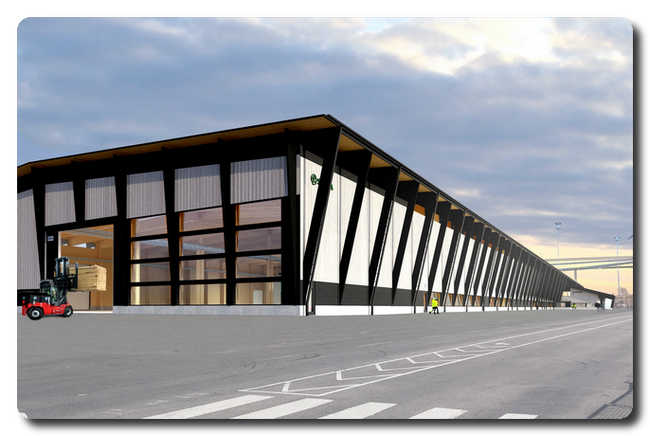
Rapid development changing the construction market
The interest in sustainable timber construction has increased significantly in the market – and the trend is continuing. In 2020, 20 percent of all newly built housing units in apartment buildings had a timber frame, which is a considerable increase compared with earlier years. Next year, 2022, the Act on Climate Declarations will also be introduced, imposing requirements to promote more sustainable construction. This is expected to further drive up the interest in CLT.
“The trend for CLT is highly positive. Today, the demand in the market is larger than the available capacity and we want to fill this gap. By developing new, innovative products, we can safeguard our competitiveness and create value for members, customers and employees – both old and new,” said Jörgen Hermansson, President of Södra Building Systems.
Carbon footprint could be reduced by 80 percent
On average, the frame accounts for nearly half of the climate footprint when constructing apartment buildings with three to eight storeys. With Södra’s frame in CLT, this figure can be reduced by up to 80 percent compared with a traditional concrete structure. This development is about to revolutionise the construction market, since industrialisation and prefabrication also enable increased productivity.
“We want to contribute to the productivity development and climate transition in the construction industry. We will do this by sharing knowledge with our stakeholders, developing our offering to the market and investing in new capacity so that our partners can continue to grow. We are now creating the conditions for the next generation of construction and providing opportunities to make a climate-conscious choice in the housing market,” said Jörgen Hermansson.
Södra’s new facility for the production of CLT is scheduled for completion in 2022. The plant premises will comprise a 270 metre-long building. The frame consists of glued-laminated timber (GLT), which is combined with CLT, naturally produced by Södra, just as Södra is responsible for the remainder of the structural timber and the cladding of the building.
Founded in 1938, Södra is Sweden’s largest forest-owner association, with 53,000 forest owners as its members. We conduct modern and responsible forestry, and operate state-of-the-art mills in which we process our raw material. In 2020, net sales amounted to SEK 20 billion and employees totalled 3,100. Through value-generating relationships and a long-term approach, Södra shows the way for the next generation of forestry.
Anritsu and Spirent Develop World-First Solution for Evaluating 5G Video Quality
Anritsu Corporation is pleased to announce availability of a new solution for evaluating video quality of 5G devices. This lab-based solution was developed in partnership with Spirent Communications plc (LSE: SPT) and leverages the strengths of Anritsu’s SmartStudio NR Network Simulator and Spirent’s Umetrix Video software, providing the world’s first integrated 5G video quality system.
Development Background
The accelerating shift from 4G to 5G mobile communications as well as increasing adoption of teleworking are driving increased viewing of streamed video content as well as growing use of online meeting tools. As a result, the video-quality experience is a key factor influencing user’s’ choice of 5G mobile operator and smartphone brand. Consequently, mobile operators, 5G device vendors, and content providers urgently need a solution for evaluating the video quality of 5G devices.

Integrated Solution
This solution integrates Anritsu’s Radio Communication Test Station MT8000A and SmartStudio NR (SSNR) control software with Spirent’s Umetrix Video system for evaluating video quality.
The MT8000A operates as a 5G Call Box by simulating a 5G base station and core network using a state-machine-based GUI. Users can simulate a full range of 5G network conditions including both Standalone (SA) and Non-Standalone (NSA) topologies at FR1 or FR2 frequencies, all without creating protocol scripts. Testing of throughput, mobility, VoNR, EPS-Fallback, SMS, CMAS, CDRX, and other functions can be easily performed using SSNR’s GUI.
SSNR’s flexible network settings as well as its simple reproduction of a live 5G network environment facilitate easy and effective analysis of video quality. Moreover, support for many APIs accelerates configuration of customer’s automation environments.
Spirent’s Umetrix Video evaluation system measures the receive-side quality of streamed video contents by scoring QoE (Quality of Experience) using Video Mean Opinion Scoring (V-MOS) from only receive-side. It supports video-streaming services and video-content analysis by scoring the original video without prior display, facilitating faster and lower-cost repeatable design tests, regression tests, and competitor benchmarking.
About Spirent Communications
Spirent Communications plc. (LSE: SPT) is a leading global provider of automated test and assurance solutions for networks, cybersecurity, and positioning. The company provides innovative products, services and managed solutions that address the test, assurance and automation challenges of a new generation of technologies, including 5G, SD-WAN, cloud, autonomous vehicles and beyond. From the lab to the real world, Spirent helps companies deliver on their promise to their customers of a new generation of connected devices and technologies. For more information, please visit www.spirent.com.
About Anritsu
Anritsu Corporation (www.anritsu.com), a global provider of innovative communications test and measurement solutions for 125 years. Anritsu’s “2020 VISION” philosophy engages customers as true partners to help develop wireless, optical, microwave/RF, and digital solutions for R&D, manufacturing, installation, and maintenance applications, as well as multidimensional service assurance solutions for network monitoring and optimization. Anritsu also provides precision microwave/RF components, optical devices, and high-speed electrical devices for communication products and systems. The company develops advanced solutions for 5G, M2M, IoT, as well as other emerging and legacy wireline and wireless communication markets. With offices throughout the world, Anritsu has approximately 3,500 employees in over 90 countries.
Essity to begin testing with LBG to make production process fossil-free
Gasum delivered the first liquefied biogas (LBG) shipment to its customer, Essity, on 22 March. Already a liquefied natural gas (LNG) customer, Essity will now test renewable LBG in an effort to make its operations and products completely fossil-free. By replacing natural gas with biogas, Essity's tissue production facility in Lilla Edet, Sweden will become emission-free during normal operations and reduce its CO2 emissions to zero.
The Swedish-based hygiene and health company Essity's production facility for tissue in Lilla Edet aims to to become the world’s first large-scale tissue facility with fossil CO2 emission-free production. After successful shorter tests during the beginning of 2021, the Lilla Edet facility will conduct a longer test run replacing natural gas with biogas as energy for the production of Tork branded and consumer tissue products.
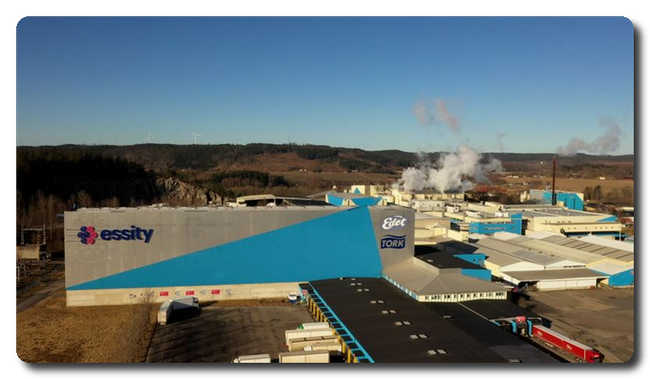
“We are very pleased that Essity has made the decision to take a step from LNG to LBG, which is an excellent choice when pursuing a fossil-free production process. We constantly aim to provide our industry customers with a unique and competitive offering, which will help them in transitioning towards more sustainable sources of energy,” Gasum’s Vice President Tommy Mattila says.
“We continually evaluate our production methods. The planning has been going on for a long time and in January we carried out the first tests, with good results. We are now launching full-scale tests with the target of becoming the world's first tissue production plant free of fossil CO2 emissions by 2021. Essity produces tissue in 19 countries. The ambition is to share our experiences with our other production facilities and together contribute to achieving our ambitious climate goals. We want to continue to break barriers to health and well-being by offering innovative and sustainable hygiene and health products”, says Christian Carlsson, Factory Manager at Edet Mill, Essity.
By 2030, Essity will reduce greenhouse gas emissions by 25 per cent for its energy and electricity use within the company and for purchased electricity, compared with the base year 2016. These are targets that have been approved by the Science Based Targets Initiative since 2018.
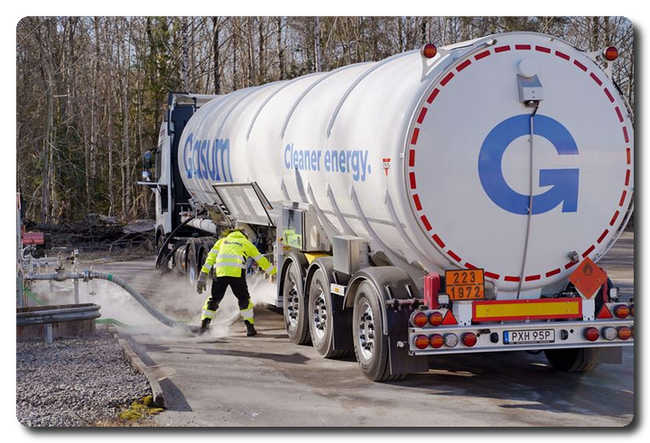
Replacing LNG with LBG
The production facility in Lilla Edet has constantly developed its production process to meet Essity's high sustainability ambitions. Recycled paper is used as a raw material and recycled fiber sludge, and collected recycled wood is used to produce steam in the solid fuel boiler, where the paper is dried. During normal operation, the solid fuel boiler has no fossil CO2 emissions. The steam is also distributed via a district heating network to the local community to provide heat.
In the final production step, hot air caps are used to dry the paper. These are heated with gas burners powered by natural gas (LNG). The tests currently being carried out mean that the natural gas will be completely replaced by biogas (LBG).
Liquefied biogas (LBG) – also known as liquefied biomethane and bio-LNG – is a fossil-free and 100% renewable fuel that can reduce CO2 emissions over its life cycle by up to 90% compared to conventional fuel.
For more information please contact:
Tommy Mattila, Vice President, Gasum
Phone +358 40 581 9247, tommy.mattila(a)gasum.com
The energy company Gasum is a Nordic gas sector and energy market expert. Gasum offers cleaner energy and energy market expert services for industry and for combined heat and power production as well as cleaner fuel solutions for road and maritime transport. The company helps its customers to reduce their own carbon footprint as well as that of their customers. Together with its partners, Gasum promotes development towards a carbon-neutral future on land and at sea. The Gasum Group has 380 employees in Finland, Norway, Sweden and Germany. The company’s revenue totaled €1,128 million in 2019. Gasum is owned by the State of Finland. www.gasum.com
COSEL adds 1500W unit to its PCA power supplies with extended communications bus for demanding medical and industrial applications
COSEL Co, Ltd (6905: Tokyo) has just announced the addition of a 1500W power supply to its PCA series with extended communications I/O for demanding medical and industrial applications. The addition of the PCA1500F complements and expands the family of power supplies to cover a much larger range of applications from 300W up to 1500W in four series. The PCA series have a built-in extended-UART (Universal Asynchronous Receiver –Transmitter) interface supporting more than 80 commands to monitor and control the whole range of power supply parameters, a PMBus option is also available.
Complying with stringent medical standards EN/IEC 60601-1, the PCA1500F features a reinforced input to output isolation of 4,000VAC and a grade of 2X Means of Patient Protection (2xMOPP). The PCA series offers a universal input voltage of 85 to 264VAC. Exhibiting flexibility, the output can be operated in constant voltage (CV) or constant current (CC) mode with either analog or digital control. All PCA series power supplies are built in 1U height housings and utilize COSEL’s high-density, integrated packaging with optimized cooling
Available in six different output voltages, the PCA series covers the whole range of applications from 5V to 48V and embraces 5, 12, 15, 24, 32 and 48V. All output voltages can be adjusted to near zero volts and operated in constant voltage or constant current mode. Worthy of highlighting, the 5V model trims down to 3V and so covers 3.3V for computing applications, and the 48V model trims up to 57.6V covering some of the growing Power over Ethernet (PoE) applications.
In addition to the main output, an independent isolated auxiliary voltage of 12V is provided which is adjustable in the range of 4.7 -12.6V DC using digital control.
 The addition of the PCA1500F complements and expands the COSEL PCA family of power supplies to cover a much larger range of applications from 300W up to 1500W in four series.
The addition of the PCA1500F complements and expands the COSEL PCA family of power supplies to cover a much larger range of applications from 300W up to 1500W in four series.
Designed for demanding applications, and in line with its predecessors, the PCA1500F combines the benefits of constant voltage and constant current, simplifying the designer’s task when developing power systems requiring both modes without adding external circuitry e.g. for lead acid battery charging requiring constant current charging up to 90%, and constant voltage above that.
For flexibility, the PCA1500F includes analog and digital interfaces - the analog interface includes current adjustment (ITRM), voltage adjustment (VTRM), remote control ON/OFF, voltage sensing, LED alarms and current monitoring. For extended flexibility, the extended-UART digital interface supports more than 80 commands for monitoring and control. Operating data can be stored and locked inside the internal memory, and recorded error codes can be used for analysis and the recording of operational hours for preventive maintenance.
All parameters can be programmed and monitored via COSEL’s extended UART control panel GUI, which is able to control up to seven units. Extended UART is built-in as standard, and a PMBus option is available.
The PCA series can easily be connected in series or parallel for extra power, and in parallel redundant mode (N+1) for improved system reliability and availability.
The PCA1500F is rated for operation at temperatures from -20 to +70 degrees C, and cooling is achieved by an internal intelligent fan, the speed of which adjusts automatically to match and work alongside environmental conditions. The fan can also be set to maximum (fixed) speed manually via the digital interface.
The PCA1500F includes inrush current limiting, over-current protection, thermal protection, and output status alarm. For safety, the power supplies have an IN/OUT isolation of 4,000VAC (2MOPP) and IN/FG of 2,000VAC (1MOPP). Output isolation to FG and other functional pins is 500VAC.
For high performance, the PCA1500F has a built-in active power factor corrector (PFC). Conducted noise complies with FCC Part 15 class A, VCCI-A, CISPR11-A, CISPR32-A, EN55011-A and EN55032-A. For applications requiring lower conducted noise, COSEL offers the NAC-30-472 filter. The harmonic current emission complies with the IEC61000-3-2 (class A).
The PCA series comes with agency approvals UL62368-1, EN62368-1, C-UL (equivalent to CAN/CSA-C22.2 No.62368-1), ANSI/AAMI ES60601-1, EN60601-1 3rd Ed., C-UL (equivalent to CAN/CSA-C22.2 No.60601-1), and complies with IEC60601-1-2 4th Ed.
All PCA units come in 1U height (41mm, 1.61 inch) Including fan. The PCA1500F has a length of 203mm (7.99 inches) and a width of 140mm (5.52 inches), the weight is 2.0kg maximum.
To accommodate application specific requirements, a number of options are available including conformal coating (C), low leakage current (G), PMBus interface (I), reverse air exhaust (F2), master-slave operation (P3) and alarm in reverse logic (W1).
PCA1500F power supplies have a five-year warranty and conform to the European RoHS Directive, REACH Directive, CB-Report and CE Marking.
Related links:
https://www.coseleurope.eu/Products/AC-DC/PCA
About Cosel:
Established in Japan 1969, COSEL is one of the world’s leading designers and manufacturers of high performance AC-DC Power Supplies, DC-DC Converters and EMI Filters. With quality, reliability & flexibility as our main focus, we pride ourselves on developing some of the highest quality and most reliable products seen anywhere in the world today. The Cosel Group is a $228m global company employing some 790 staff with sales offices throughout Japan, Asia, Europe and North America. Our product range is aimed mostly at demanding applications within the Industrial, Factory Automation, Medical, Telecoms, Lighting, Audio/Broadcast & Renewable Energy sectors. A flexible approach with full in-house design means we deliver products using the very latest technology meeting the growing demands of our customers.
Linxon secures position on National Grid EPC substations framework
Linxon has secured a position as a framework contractor for National Grid’s RIIO-2 substations framework which runs from 2021 to 2026 with optional extension periods.
This framework will involve Linxon providing its market leading technical / equipment innovation, system integration and construction knowledge across National Grid’s vast English and Welsh 132 kV to 400 kV transmission network, whilst supporting both organisations’ drive towards NetZero. The framework activities will range from small substation extensions and refurbishment to large scale, innovative, new build substation requirements.
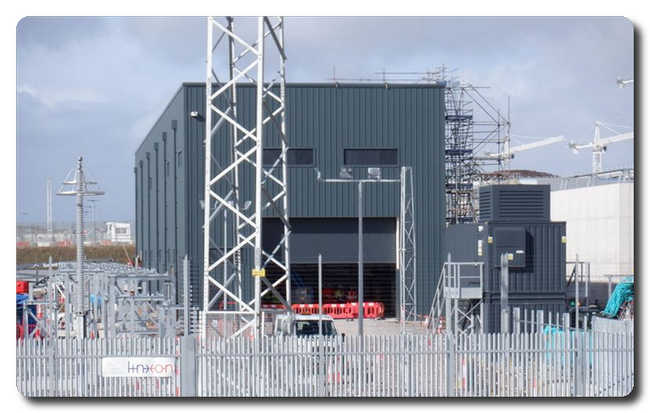
“We are delighted to have been selected by National Grid to enter into a further long-term relationship and secure our place on this exciting EPC (Engineering, Procurement and Construction) substation framework. With Linxon’s parentage, this award builds on many decades of collaboration and successful delivery between our organisations and I look forward to continuing this over the next 5 years with a firm focus upon achieving our shared NetZero ambitions”, said Jon Downs, Managing Director of Linxon UK.
Linxon commenced operations on September 1, 2018, undertaking turnkey electrical alternating current substation projects related to renewable and conventional power generation, power transmission and transportation solutions. Substations enable the efficient and reliable transmission and distribution of electricity. Within the substation, switchgear controls and protects the network from power outages and facilitates reliable electricity supply.
About Linxon
We combine Hitachi ABB Power Grids deep technological knowledge and SNC-Lavalin’s project management expertise to create a company dedicated to substations. As one of the leading engineering companies, we help our customers with turnkey solutions in the field of substations for power transmission, renewable energy and transportation. As a single point of contact we combine the accumulated knowhow of key-suppliers and contractors so that customers benefit from efficient solutions, increased industrial productivity and a lower environmental impact. We work to shape energy solutions to empower sustainable connectivity. linxon.com
Metso Outotec receives order for a mine conveyor system in South America
Metso Outotec has received an order for a heavy-duty mine conveyor system in South America. The delivery consists of high reliability overland conveyors, including a 2-km single flight conveyor. Equipment provided in this package runs at speeds of up to 6 m/s with a delivery capacity of over 9,000 t/h. The order value is approximately EUR 10 million and it has been booked in Minerals’ Q1/2021 orders received.
“Metso Outotec’s full range of overland conveyor solutions provides economic and reliable material transportation for both open-pit and underground operations at the lowest total cost of ownership. Metso Outotec’s patented Energy Saving Idlers (ESI) bring important power savings to long-distance conveyors, reduced belt tension, and extended rollers life, enabling a reduced maintenance cost over the equipment life and a more sustainable operation,” says Alexandre Martins, Business Manager, Crushing and Conveying Systems business line at Metso Outotec.
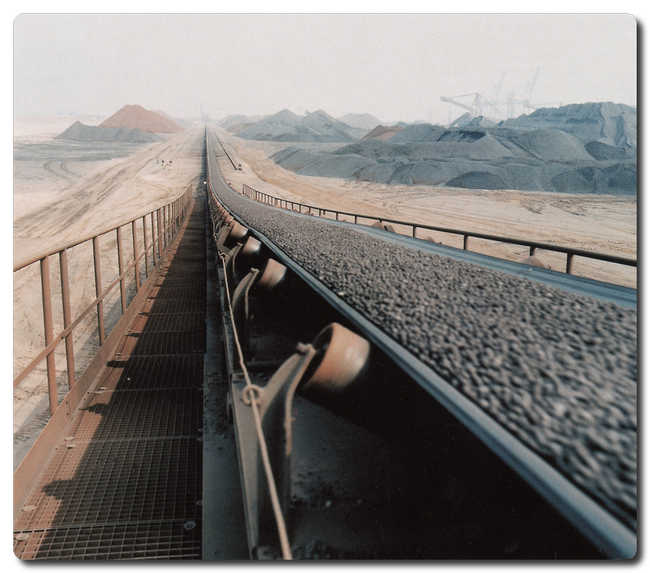 mine conveyor system
mine conveyor system
The Metso Outotec conveyor offering covers complete end-to-end conveyor solutions. This includes concept studies and definitions for all types of terrains and route types with horizontal and vertical curves. In addition, the offering also includes post-installation services and maintenance, including a full range of accessories, belts, and components for different types of applications. Metso Outotec conveyors are built from high-quality materials and are based on extensive testing and more than 100 years of engineering experience.
Find out more about Metso Outotec conveyor solutions on our website.
Further information, please contact:
Erwin Alexandre Huber, Vice President, Crushing and Conveying Systems, Metso Outotec Corporation, Tel. +55 15 2102 1386, erwin.huber(at)mogroup.com
Helena Marjaranta, Vice President, Communications and Brand, Metso Outotec, Tel. +358 20 484 3212, email: helena.marjaranta(at)mogroup.com
Metso Outotec is a frontrunner in sustainable technologies, end-to-end solutions and services for the aggregates, minerals processing and metals refining industries globally. By improving our customers’ energy and water efficiency, increasing their productivity, and reducing environmental risks with our product and process expertise, we are the partner for positive change.
Metso Outotec is committed to limiting global warming to 1.5°C with Science Based Targets. We ranked 8th on the 2021 Global 100 list of the world’s most sustainable companies.
Headquartered in Helsinki, Finland, Metso Outotec employs over 15,000 people in more than 50 countries and its sales for 2020 were about EUR 3.9 billion. The company is listed on the Nasdaq Helsinki. mogroup.com
Valero deal for Foster Wheeler at UK refinery
Zug, Switzerland – Foster Wheeler has signed an 'evergreen agreement' with Valero Energy Ltd for the provision of home office engineering and project support services to Valero’s Pembroke Refinery and other facilities in the UK. Foster Wheeler will provide home office front-end engineering design and detailed engineering design services to support new development and modification projects at the Pembroke Refinery and other facilities.
Foster Wheeler will provide home office front-end engineering design and detailed engineering design services to support new development and modification projects at the Pembroke Refinery and other facilities.
Foster Wheeler will also provide other support services including project control and cost estimating. Valero acquired the Pembroke refinery in 2011.
“We know this refinery well, having executed projects for the refinery since the 1980s,” said Umberto della Sala, President and chief operating officer of Foster Wheeler AG, adding that the company has executed projects for Valero elsewhere, particularly in the US.
Rowecord goes into administration
Accountancy firm Grant Thornton’s advisory team has been appointed administrators to Wales-based Rowecord Engineering Limited, which went into administration with the potential loss of several hundred jobs.
Alistair Wardell, senior partner at the Wales office of Grant Thornton in Cardiff, will lead the administration of the UK's third-largest structural steel engineering company.
Rowecord, which until recently employed over 500 staff at sites in Newport, Baglan and the Tata Steelworks in Port Talbot, built the roof at the London Olympics Aquatic Centre, as well as the stadiums for Cardiff City Football club and the Llanelli Rugby Club (Parc y Scarlets).
It is currently working on major projects at the Dover Docks and the British Museum and recently built the blast furnace for Tata at Port Talbot, where it has 120 people on site providing general maintenance.

In calling in administrators, Newport-based Rowecord’s Managing Director Andrew Hoppe said the company had “exhausted every option to sustain the business for the future.”
Administrator Alistair Wardell said: “This is a devastating blow, not just for the Rowecord workforce which will be affected, but for the Welsh economy as a whole.
“It is also likely to have an impact on a number of other companies along the M4 corridor that up until now have been suppliers to Rowecord.
“Among our roles as administrators will be to explore which, if any, parts of the business can be salvaged and whether any jobs can be saved.
“A number of Rowecord employees will be retained in the short term post-administration to complete work in progress.”
TMO to build 2nd gen biofuel plant in Brazil
Guildford, UK – TMO Renewables (TMO), a UK developer of second generation biofuels technology, and Usina Santa Maria Ltda are to form a JV to build the first commercial production plant in Brazil to convert sugar cane waste (bagasse) to cellulosic bioethanol. 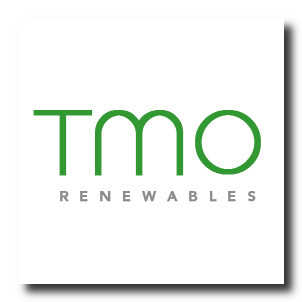 Under an MOU, TMO is to build, own and operate a 10-million-litre second generation ethanol pilot plant to convert bagasse to cellulosic bioethanol.
Under an MOU, TMO is to build, own and operate a 10-million-litre second generation ethanol pilot plant to convert bagasse to cellulosic bioethanol.
This will be followed by the construction of full-scale industrial plant, alongside a sugar mill owned by Usina Santa Maria at Cerquilho, São Paulo state. The facility is due to go into production in 2014.
The bioethanol will primarily be used to power Flex-Fuel vehicles in the domestic market. The project is expected to create over 150 new jobs for British engineers.
Brazil is the second largest producing nation of First Generation ethanol with a rapidly-developing demand for ethanol to replace hydrocarbon fuels. In September 2012, TMO signed a Letter of Intent to secure long-term supply of feedstock.
The MOU guarantees a 20-year supply of feedstock as part of the joint venture to build the pilot plant.
Challenging opportunities
 Edited speech by Bob Dudley, BP group chief executive, at CERA Week, 6 March 2013:
Edited speech by Bob Dudley, BP group chief executive, at CERA Week, 6 March 2013:
I am often reminded of the contrast between the comfortable places where we discuss and consume energy and the sometimes inhospitable places where we produce it.
In order that people can live in comfort, the natural resource industries need to go to remote, challenging and often hostile environments to access the necessary sources of energy for society.
There is not a nation on earth where people aren’t relying on us every day to deliver the energy they need to do their jobs, heat their homes, get their children to school, and countless other needs. That’s how people emerge from poverty, economies grow and the standard of living rises.
In business we often talk of challenges and opportunities. What we face today in energy is a series of challenging opportunities — from the shales of America to the snows of Siberia.
The opportunities are plentiful, but they are also complex and difficult. And from BP’s perspective, and many other companies in our industry, the message is that we have learned from recent events and we plan to address those opportunities safely, responsibly and reliably.
We estimate that global energy demand is likely to grow by more than a third between now and 2030. According to the projections we make in our Energy Outlook 2030 publication, emerging economies such as China and India are likely to account for almost all that growth — over 90% of it.
Non-fossil energy — nuclear, hydro, biofuels and other renewables — will grow faster as a group than any fossil fuel. But they start from a very low base and will only provide, on a combined basis, about a fifth of all energy in 2030.
Gas will be the fastest growing fossil fuel at around two percent annually. It’s clean, cheap and increasingly available.
Oil will grow more slowly, at less than one percent per year. But that still means the world will need around 16 million barrels a day more in 2030 than today. Let us pause on what that means — that increase alone is nearly the combined daily 2011 production of Russia, Canada and the United Arab Emirates.
Turning to supply, many in the industry used to worry about whether demand on this scale could be met — we weren’t among them, by the way — but there hasn’t been much talk about “peak oil” lately.
Thanks to new frontiers such as shale and the deepwater, our industry is now producing an enormous amount of previously unreachable oil and gas. At current consumption rates, the data suggests the world has 54 years’ worth of proved oil reserves and 64 years’ worth of proved gas reserves in place — and more will be found.
So we are working in a world with ever more diverse sources of supply — and diversity of course increases energy security by avoiding over dependence on any one source.
However this diversity comes at a price. Many of the new supplies are in places that are hard-to-get at: shale oil and gas, tight oil and gas, heavy oil, the deepwater — and, in due course, the Arctic Circle.
And the physical and technological risks are not the only ones. Other factors range from fiscal regimes and other policy-related issues, to geo-political tensions and even the risk of terrorism.
We at BP were brutally reminded of that fact a few weeks ago, when four of our employees and colleagues from other companies were murdered in the terrorist attack on the In Amenas gas plant in Algeria.
Our thoughts are very much with the loved ones of those who died, from BP, Statoil, JGC and other organizations. And our sincere gratitude goes to all who have offered support and sympathy.
BP and Statoil staff and the contracting companies, are incredibly resilient and committed people and we will go on. We will never forget but we will go on with our mission of providing energy to the world. We have spent over 100 years producing energy in tough surroundings and we will not be deterred.
But the new opportunities bring new challenges, and we need constantly to develop our technology, capability and risk management.
When Colonel Drake drilled the first modern oil well in Pennsylvania in 1859, he gave birth to a new industry – and one where the US has held the technology edge ever since.
Forty years ago this year, however, there was an oil shock and a future of scarce energy or even “resource wars” was predicted.
BP never subscribed to those fears, and in the last five years, the situation has been transformed.
US crude oil production has soared from an average of five million barrels per day in 2008 to over 7 million barrels per day at the beginning of this year, according to the US Energy Department.
Deepwater Gulf of Mexico exploration and production scarcely existed 20 years ago. In 2011, it provided about 18% of US daily crude production. Alaskan oil was widely expected to run out in late 1990s, yet it is still producing.
North Dakota, which was on hardly anyone’s radar screen a few years ago, has seen its production soar from just over 100,000 barrels per day in 2006 to over a three-quarters of a million last December. Not only has that state now surpassed Alaska as America’s second-largest oil producer, it also pumps more oil per day than the OPEC nation of Ecuador.
Why is this happening? Resources below ground are a prerequisite, but favorable conditions above the ground are also essential.
Almost uniquely among the nations of the world, the US allows private citizens to own the mineral rights beneath their property, “from the Earth’s core to the sky.” In most states, this gives private individuals a personal stake in energy development. It incentivizes entrepreneurs to compete with each other to develop the technologies to access the wealth that lies underground.
So it isn’t surprising that the world-changing technologies of the last two decades were all either developed or advanced in the US: horizontal drilling, hydraulic fracturing — pioneered incidentally by Amoco in the 1940s — to deepwater equipment and of course the 3D and 4D seismic we and others have used to great effect in the Gulf of Mexico and in countries such as Angola and Azerbaijan.
Here is another fact that certainly needs repeating. This industry is not only transforming the energy of America but also the economy of America. Energy has rightly been called the number one job-creating sector in the US economy, with oil and gas employment rising a remarkable 27% since 2008.
And jobs are being created well beyond traditional energy regions, including what some used to call Rust Belt states like Pennsylvania and Ohio. It is a great renaissance. BP has just returned to exploration in Ohio, for example. Increased reserves and lower natural gas prices are also attracting new US investments in manufacturing. Oil and gas taxes are pouring into the Federal Treasury and into many state governments.
Import dependence is falling. In fact, with the abundance of domestic natural gas, a number of LNG export projects are now in the queue, awaiting federal government approval. Just last month, BP signed a 20-year LNG export agreement with Freeport LNG here in Texas.
This sector is turning around America’s balance of trade, helping it compete internationally, creating jobs and breathing new life into its economy. Colleagues — America should be very proud of its energy industry today.
But this is not the only land of opportunity. Many other growing regions are represented here today — including many from Russia
Russia is the biggest country in the world. It also has the largest combined oil and gas reserves, as well as the highest combined production of oil and gas. And in our view, its potential has yet to be realized.
There is enormous scope for increasing Russia’s production — through enhanced recovery in brownfield developments in the Western Siberian and the Volga Urals fields. And also through exploration and production in greenfield developments in Eastern Siberia and the Yamal Peninsula. Russia also has the potential to develop its own shale and tight oil.
What Russia and the US have in common is that each will require energy investment on an epic scale, undertaken by energy partners who are not daunted by the obstacles and have the resources, experience, capability and appetite for the task.
We are a global company and select investments carefully from a world of opportunities. We have gas plays in Asia and the Middle East, and deepwater possibilities in the Atlantic and Indian Oceans, from Africa to South America, the South China Sea and the Great Australian Bight.
And in terms of our own company, if I may end on this note, we have faced challenges in recent years — in America, Russia and elsewhere. But as I said at the beginning, this is not a business for the faint-hearted or the easily discouraged. And we are neither.
